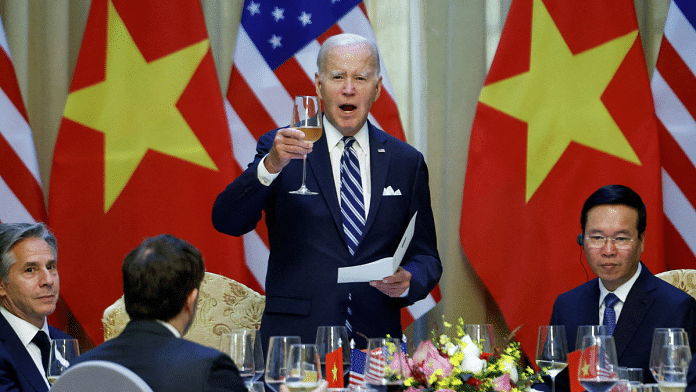New Delhi: Former United States secretary of state Henry Kissinger famously referred to North Vietnam under communist control as a “fourth-rate” power in 1969. Fifty-four years later, President Joe Biden called Vietnam a “critical partner” while speaking at the Central Hall of the Communist Party of Vietnam Sunday.
Biden was in Vietnam for a two-day state visit after the G20 Summit in New Delhi.
The US and Vietnam Sunday elevated their relationship to that of a ‘Comprehensive Strategic Partnership,’ for the purposes of peace, cooperation and sustainable development, according to the Joint Leaders’ Statement published Monday.
“Today, we can trace a 50-year arc of progress in the relationship between our nations from conflict to normalisation,” said President Biden, while also calling the Indo-Pacific region “one of the most consequential regions in the world” during a press conference in Hanoi Sunday.
The elevation comes 50 years after the US withdrew its last combat troops from Saigon (now Ho Chi Minh City) on 29 March 1973, after a brutal eight-year direct intervention in the Vietnam War. Over 58,000 US soldiers reportedly lost their lives during the war — a situation that flummoxed five US presidents during their tenure, from Harry Truman to Richard Nixon.
In 1964, the US first embargoed trade with North Vietnam, which President Gerald Ford later expanded to cover all of Vietnam after the fall of Saigon in 1975. The situation remained unchanged till 3 February 1994, when President Bill Clinton lifted the embargo.
Since 1994, the relationship between the US and Vietnam has evolved to the point where the two countries are engaged in cooperation in several domains, including climate change, economy and tourism.
From 1954 until the fall of Saigon in 1975, Vietnam was divided into the Democratic Republic of Vietnam (North Vietnam), which was founded by Ho Chi Minh, and the State of Vietnam — later the Republic of Vietnam (South Vietnam) — founded in 1954 after the temporary division of Vietnam at the 17th parallel north latitude.
ThePrint explains how Vietnam went from being a “fourth-rate power” to a “critical partner” of the US.
Also Read: US-EU announce support for Angola-Zambia-DRC corridor as race for critical minerals heats up
A brief history of bilateral ties
On 2 September 1945, Ho Chi Minh, the leader of the Viet Minh — a communist movement for Vietnamese independence that had opposed both the country’s French colonial rulers and the Japanese — declared Vietnam’s independence at Ba Dinh Square in Hanoi.
He began his speech by quoting the US Declaration of Independence: “all men are created equal. They are endowed by their Creator with certain inalienable rights, among them are Life, Liberty, and the pursuit of Happiness.”
Throughout World War 2, the Viet Minh, supported by the US Office of Strategic Services (OSS), the predecessor of the Central Intelligence Agency (CIA), had fought a guerrilla war against both Vichy France and Japan.
President Franklin D. Roosevelt of the US was reportedly against the return of French colonial rule over Indochina. (French Indochina was the term used for French territories in Southeast Asia, including Vietnam.) But his successor, Harry S. Truman, said to be a fervent anti-communist, acquiesced to the return of Indochina to French rule.
Barely months after the end of World War 2, another war began in Indochina between the Viet Minh and the French. The US at first was not an active participant in the war, but provided funding to the French in their efforts to maintain colonial control over Indochina. This continued until the defeat of the French forces at Dien Bien Phu in 1954.
After the Geneva Accords of 1954 was signed and France agreed to leave Indochina, the country was divided into communist-controlled North Vietnam and the now US-allied South Vietnam.
This eventually led to the US actively participating in the war between the two Vietnams — particularly taking an active role after the Gulf of Tonkin incident in 1964; by 1967, more than 5,00,000 US combat troops were deployed.
US-Vietnam relations today
After Clinton’s decision to lift the embargo in 1994, Vietnam and the US signed a Bilateral Trade Agreement (BTA) that came into effect in December 2001, extending to Vietnam a conditional most-favoured nation (MFN) trade status.
Eventually in 2013, the US and Vietnam launched a comprehensive partnership under President Barack Obama and President Truong Tan Sang of Vietnam. The comprehensive partnership focused on maritime cooperation, economic engagement, climate change, education cooperation and promoting respect for human rights.
On Sunday, this partnership was elevated to that of a comprehensive strategic partnership. Under the new partnership, the US and Vietnam will coordinae on regional and global issues, and deepen political and diplomatic relations as well as economic and trade cooperation.
The partnership will also promote collaboration in the science, technology and digital domains, the education and training sectors, climate, and the energy and health fields. Moreover, it will also address war legacies, culture, tourism and people-to-people ties, defence and security matters and the promotion and protection of human rights.
(Edited by Richa Mishra)
Also Read: Biden urges G20 partners to help ‘scale up’ World Bank so it can better support developing countries



